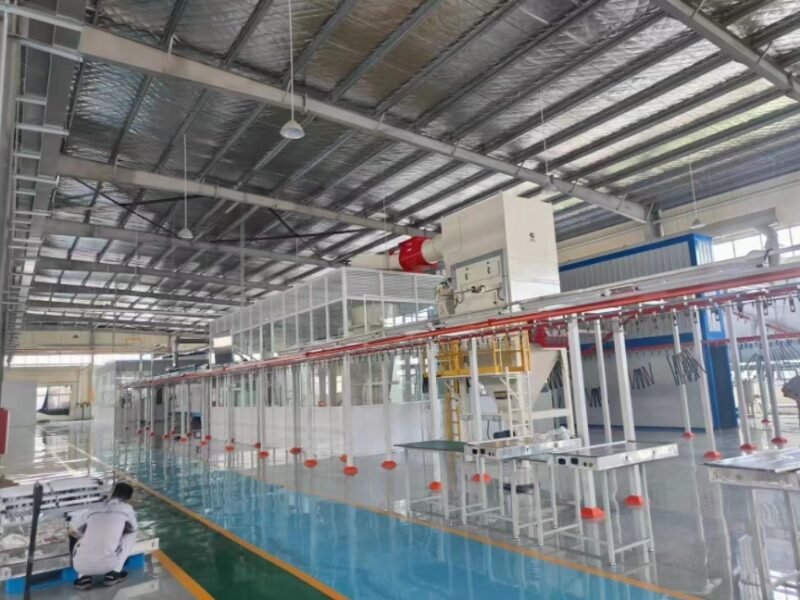
What is the difference between metal powder spraying and ordinary powder spraying?
What is the difference between metal powder spraying and ordinary powder spraying?
### **Difference Between Metal Powder Spraying and Ordinary Powder Spraying**
The main difference between **metal powder spraying** and **ordinary powder spraying** lies in the **type of powders used**, their **applications**, and the **properties of the final coating**. Let’s break it down:
—
## **1️⃣ Powder Material Type**
### **Metal Powder Spraying**
– **Powder Used**: The powder is typically made from **metallic materials** such as **aluminum, zinc, copper, bronze**, or **stainless steel**.
– **Characteristics**: The powder consists of **fine metal particles** designed to create a **metallic coating** that provides specific benefits such as **corrosion resistance**, **wear resistance**, and **thermal protection**.
### **Ordinary Powder Spraying**
– **Powder Used**: This usually refers to **non-metallic powders** such as **epoxy**, **polyester**, **polyurethane**, and **acrylic**.
– **Characteristics**: These powders are typically designed for **decorative finishes**, **corrosion protection**, and **aesthetic qualities**. They provide a **smooth, durable coating** that is ideal for applications where appearance, protection from the elements, and wear resistance are crucial.
—
## **2️⃣ Applications**
### **Metal Powder Spraying**
– **Common Uses**:
– **Protective coatings** for **metal parts** exposed to extreme conditions (e.g., **engine components**, **marine parts**, and **industrial machinery**).
– **Surface restoration** for **worn metal components** (e.g., **shafts, turbines, molds**).
– **Corrosion protection** in harsh environments (e.g., **zinc for galvanizing steel**).
– **Wear-resistant coatings** for components exposed to friction (e.g., **gear parts, cutting tools**).
### **Ordinary Powder Spraying**
– **Common Uses**:
– **Decorative and protective coatings** for **automotive parts**, **appliances**, **furniture**, and **architectural elements**.
– **General corrosion resistance** for **indoor applications** (e.g., **light fixtures, machinery frames**).
– **Color finishes** and **aesthetic coatings** on **metal**, **wood**, **plastic**, and **other materials**.
—
## **3️⃣ Coating Properties**
### **Metal Powder Spraying**
– **Properties**:
– Creates **metallic, thick coatings** that offer high **thermal conductivity**, **strength**, and **corrosion resistance**.
– Metal coatings can often be **fused** to the surface or **laminated** for added protection.
– Provides **wear resistance** and **thermal protection**, making it suitable for high-stress environments.
– Commonly results in a **matte or metallic finish**, though some can be polished or textured.
### **Ordinary Powder Spraying**
– **Properties**:
– Produces **smooth, even finishes** that are resistant to **scratches**, **chipping**, and **UV degradation**.
– Offers **color flexibility** and **a wide range of textures** (smooth, glossy, matte, wrinkle, etc.).
– Coatings are typically **non-porous**, providing excellent **corrosion resistance** for indoor and some outdoor uses.
– Commonly used for **decorative** purposes and is less likely to provide the same level of **wear resistance** or **thermal conductivity** as metal powders.
—
## **4️⃣ Application Techniques**
### **Metal Powder Spraying (Thermal Spraying or Metalizing)**
– **Methods**:
– **Flame Spraying** – Powder is melted by an oxy-fuel flame and sprayed onto the substrate.
– **Arc Spraying** – Electric arc is used to melt metal powder, which is then atomized and sprayed.
– **Plasma Spraying** – A high-temperature plasma arc is used to melt and spray metal powders onto the surface.
– **High-Velocity Oxygen Fuel (HVOF) Spraying** – Utilizes high-speed gas flow to deposit metal powder onto the surface.
– **Coating Thickness**: Typically **thicker** coatings (100-1000 microns).
### **Ordinary Powder Spraying (Electrostatic Powder Coating)**
– **Method**:
– The powder is applied using an **electrostatic spray gun**, where the powder is charged and attracted to the grounded surface.
– The coated object is then **baked in an oven** to cure the powder and form a smooth, solid coating.
– **Coating Thickness**: Typically **thinner** coatings (40-150 microns).
—
## **5️⃣ Durability and Resistance**
### **Metal Powder Spraying**
– **Durability**: Offers superior **wear resistance**, **thermal resistance**, and **abrasion resistance**.
– **Corrosion Resistance**: **Zinc, aluminum, and other metal powders** offer excellent **corrosion protection**, especially in **harsh outdoor or marine environments**.
– **Heat Resistance**: Metal coatings provide good **thermal protection** and are often used in high-temperature applications.
### **Ordinary Powder Spraying**
– **Durability**: Offers **excellent UV resistance**, **corrosion resistance** (especially for mild conditions), and **scratch resistance** for decorative and general industrial uses.
– **Corrosion Resistance**: Provides **strong protection** for most indoor and **light outdoor applications**.
– **Heat Resistance**: Not typically used for high-temperature applications, although **some powder coatings** (e.g., **epoxy-polyester hybrid powders**) are rated for **moderate heat**.
—
## **Summary Table**
| **Feature** | **Metal Powder Spraying** | **Ordinary Powder Spraying** |
|—————————-|—————————————————–|—————————————————-|
| **Powder Material** | Metal powders (aluminum, zinc, copper, stainless) | Non-metallic powders (epoxy, polyester, acrylic) |
| **Application** | Industrial, aerospace, automotive, wear protection | Decorative finishes, general corrosion protection |
| **Coating Properties** | High thermal, wear, and corrosion resistance | Smooth, aesthetic, UV and chemical resistance |
| **Techniques** | Flame spraying, arc spraying, plasma spraying | Electrostatic spraying and curing in an oven |
| **Durability** | Superior wear, corrosion, and heat resistance | Excellent for moderate conditions, mainly indoors |
| **Typical Uses** | Marine parts, machinery, thermal protection, restoration | Furniture, automotive parts, appliances, indoor decor |
—
### **Conclusion**
The main difference between **metal powder spraying** and **ordinary powder spraying** lies in the **type of materials used** and the **performance requirements** of the coating. **Metal powder spraying** is ideal for high-performance applications that require **corrosion, wear, and thermal protection**, while **ordinary powder spraying** is more suited for **aesthetic finishes** and **moderate environmental conditions**.
Would you like to explore more about a specific technique or application? 😊
electrostatic spraying cleaning
electrostatic spraying definition
electrostatic spraying process
electrostatic spraying services
electrostatic spraying systems prices
electrostatic spraying technology
electrostatic ulv sprayer
electrostatic victory sprayer
electrostatic vineyard sprayer
emist 360 electrostatic sprayer
emist epix360 electrostatic sprayer

